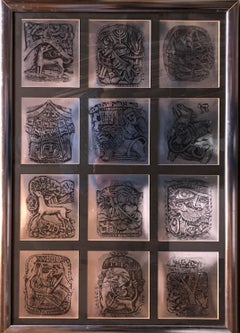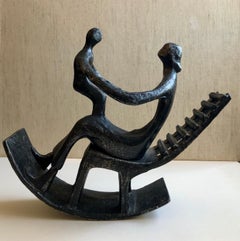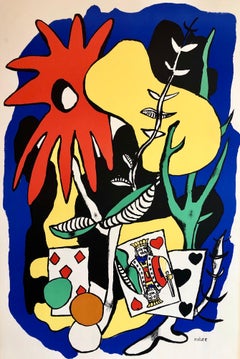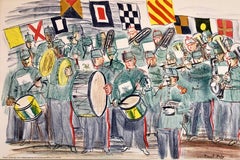Want more images or videos?
Request additional images or videos from the seller
1 of 16
UnknownIn the style of Henry Moore, Mother and Child in Rocking Chairc.1950s
c.1950s
$2,200List Price
About the Item
- Creation Year:c.1950s
- Dimensions:Height: 14 in (35.56 cm)Width: 13.5 in (34.29 cm)Depth: 6.25 in (15.88 cm)
- Medium:
- Movement & Style:
- Period:
- Condition:good condition with minor wear commensurate with age. some loss to patina where it touches the table.
- Gallery Location:Surfside, FL
- Reference Number:1stDibs: LU3823824372
About the Seller
4.9
Platinum Seller
Premium sellers with a 4.7+ rating and 24-hour response times
Established in 1995
1stDibs seller since 2014
1,841 sales on 1stDibs
Typical response time: 1 hour
Authenticity Guarantee
In the unlikely event there’s an issue with an item’s authenticity, contact us within 1 year for a full refund. DetailsMoney-Back Guarantee
If your item is not as described, is damaged in transit, or does not arrive, contact us within 7 days for a full refund. Details24-Hour Cancellation
You have a 24-hour grace period in which to reconsider your purchase, with no questions asked.Vetted Professional Sellers
Our world-class sellers must adhere to strict standards for service and quality, maintaining the integrity of our listings.Price-Match Guarantee
If you find that a seller listed the same item for a lower price elsewhere, we’ll match it.Trusted Global Delivery
Our best-in-class carrier network provides specialized shipping options worldwide, including custom delivery.You May Also Like
Study/Falling Man (Series I)
By Ernest Tino Trova
Located in Missouri, MO
Study/Falling Man (Series I)
By. Ernest Tino Trova (American, 1927-2009)
24 x 24 inches
Wrapped to Foam Core
Signed Artist Proof Lower Right
Ernest Tino Trova (American, 1927-2009)
...
Category
1960s American Modern Abstract Prints
Materials
Screen
Study/Falling Man (Series II)
By Ernest Tino Trova
Located in Missouri, MO
Study/Falling Man (Series II), 1967
By. Ernest Tino Trova (American, 1927-2009)
24 x 24 inches
Wrapped on Foam core
Signed Artist Proof Lower Right
Ernest Tino Trova (American, 1927...
Category
1960s American Modern Abstract Prints
Materials
Screen
Study/Falling Man (Series I)
By Ernest Tino Trova
Located in Missouri, MO
Study/Falling Man (Series I), 1967
By. Ernest Tino Trova (American, 1927-2009)
24 x 24 inches
Wrapped to Foam Core
Signed Artist Proof Lower Right
Ernest Tino Trova (American, 1927-...
Category
1960s American Modern Abstract Prints
Materials
Screen
Study/Falling Man (Series II)
By Ernest Tino Trova
Located in Missouri, MO
Study/Falling Man (Series II), 1967
By. Ernest Tino Trova (American, 1927-2009)
24 x 24 inches
Signed Artist Proof Lower Right
Wrapped to Foam Core
Ernest Tino Trova (American, 1927...
Category
1960s American Modern Abstract Prints
Materials
Screen
Study/Falling Man (Series II)
By Ernest Tino Trova
Located in Missouri, MO
Study/Falling Man (Series II), 1967
By. Ernest Tino Trova (American, 1927-2009)
24 x 24 inches
Wrapped to Foam Core
Signed Artist Proof Lower Right
Ernest Tino Trova (American, 1927...
Category
1960s American Modern Abstract Prints
Materials
Screen
Study/Falling Man (Series II)
By Ernest Tino Trova
Located in Missouri, MO
Study/Falling Man (Series II), 1967
By. Ernest Tino Trova (American, 1927-2009)
24 x 24 inches
Wrapped to Foam Core
Signed Artist Proof Lower Right
Ernest Tino Trova (American, 1927...
Category
1960s American Modern Abstract Prints
Materials
Screen
Study/Falling Man (Series I)
By Ernest Tino Trova
Located in Missouri, MO
Study/Falling Man (Series I), 1967
By. Ernest Tino Trova (American, 1927-2009)
24 x 24 inches
Wrapped to Foam Core
Signed Artist Proof Lower Right
Ernest Tino Trova (American, 1927-...
Category
1960s American Modern Abstract Prints
Materials
Screen
Study/Falling Man (Series II)
By Ernest Tino Trova
Located in Missouri, MO
Study/Falling Man (Series II)
By. Ernest Tino Trova (American, 1927-2009)
24 x 24 inches
Wrapped to Foam Core
Signed Artist Proof Lower Right
Ernest Tino Trova (American, 1927-2009)...
Category
1960s American Modern Abstract Prints
Materials
Screen
Study/Falling Man (Series I)
By Ernest Tino Trova
Located in Missouri, MO
Study/Falling Man (Series I), 1967
By. Ernest Tino Trova (American, 1927-2009)
24 x 24 inches
Wrapped to Foam Core
Signed Artist Proof Lower Right
Ernest Tino Trova (American, 1927-...
Category
1960s American Modern Abstract Prints
Materials
Screen
Study/Falling Man (Series II)
By Ernest Tino Trova
Located in Missouri, MO
Study/Falling Man (Series II), 1967
By. Ernest Tino Trova (American, 1927-2009)
24 x 24 inches
Wrapped to Foam Core
Signed Artist Proof Lower Right
Ernest Tino Trova (American, 1927...
Category
1960s American Modern Abstract Prints
Materials
Screen
More From This Seller
View AllMod 1970s Israeli Judaica Foil Print 12 Tribes of Israel Zodiac Signs Hebrew
Located in Surfside, FL
Genre: Israeli Batia Adith
Subject: Biblical
Medium: Print
Surface: Paper
Dimensions w/Frame: 30 1/2" x 21 1/2"
Category
1970s Modern Figurative Prints
Materials
Foil
In the style of Henry Moore, Mother and Child in Rocking Chair
Located in Surfside, FL
This is a cast metal sculpture of a woman and child, mother and baby in a rocking chair. It has a patina on a white metal. Not sure if it is steel or aluminum. It is and older vintage piece and has wear to patina where it sits and rocks on table. It is not signed or numbered and there is no foundry mark. Hence it is being sold as being after or in the manner of Henry Moore.
Henry Spencer Moore (1898 – 1986)
Moore was born in Castleford, the son of a coal miner. He became well-known through his carved marble and larger-scale abstract cast bronze sculptures, and was instrumental in introducing a particular form of modernism to the United Kingdom later endowing the Henry Moore Foundation, which continues to support education and promotion of the arts.
After the Great War, Moore received an ex-serviceman's grant to continue his education and in 1919 he became a student at the Leeds School of Art (now Leeds College of Art), which set up a sculpture studio especially for him. At the college, he met Barbara Hepworth, a fellow student who would also become a well-known British sculptor, and began a friendship and gentle professional rivalry that lasted for many years. In Leeds, Moore also had access to the modernist works in the collection of Sir Michael Sadler, the University Vice-Chancellor, which had a pronounced effect on his development. In 1921, Moore won a scholarship to study at the Royal College of Art in London, along with Hepworth and other Yorkshire contemporaries. While in London, Moore extended his knowledge of primitive art and sculpture, studying the ethnographic collections at the Victoria and Albert Museum and the British Museum.
Moore's familiarity with primitivism and the influence of sculptors such as Constantin Brâncuși, Jacob Epstein, Henri Gaudier-Brzeska and Frank Dobson led him to the method of direct carving, in which imperfections in the material and marks left by tools became part of the finished sculpture. After Moore married, the couple moved to a studio in Hampstead at 11a Parkhill Road NW3, joining a small colony of avant-garde artists who were taking root there. Shortly afterward, Hepworth and her second husband Ben Nicholson moved into a studio around the corner from Moore, while Naum Gabo, Roland Penrose, Cecil Stephenson and the art critic Herbert Read also lived in the area (Read referred to the area as "a nest of gentle artists"). This led to a rapid cross-fertilization of ideas that Read would publicise, helping to raise Moore's public profile. The area was also a stopping-off point for many refugee artists, architects and designers from continental Europe en route to America—some of whom would later commission works from Moore.
In 1932, after six year's teaching at the Royal College, Moore took up a post as the Head of the Department of Sculpture at the Chelsea School of Art. Artistically, Moore, Hepworth and other members of The Seven and Five Society would develop steadily more abstract work, partly influenced by their frequent trips to Paris and their contact with leading progressive artists, notably Pablo Picasso, Georges Braque, Jean Arp and Alberto Giacometti. Moore flirted with Surrealism, joining Paul Nash's modern art movement "Unit One", in 1933. In 1934, Moore visited Spain; he visited the cave of Altamira (which he described as the "Royal Academy of Cave Painting"), Madrid, Toledo and Pamplona. Moore made his first visit to America when a retrospective exhibition of his work opened at the Museum of Modern Art in New York City.[28]
Before the war, Moore had been approached by educator Henry Morris, who was trying to reform education with his concept of the Village College. Morris had engaged Walter Gropius as the architect for his second village college at Impington near Cambridge, and he wanted Moore to design a major public sculpture for the site.
In the 1950s, Moore began to receive increasingly significant commissions. He exhibited Reclining Figure: Festival at the Festival of Britain in 1951, and in 1958 produced a large marble reclining figure for the UNESCO building in Paris. With many more public works of art, the scale of Moore's sculptures grew significantly and he started to employ an increasing number of assistants to work with him at Much Hadham, including Anthony Caro and Richard Wentworth.
Moore produced at least three significant examples of architectural sculpture during his career. In 1928, despite his own self-described "extreme reservations", he accepted his first public commission for West Wind for the London Underground Building at 55 Broadway in London, joining the company of Jacob Epstein and Eric Gill. At an introductory speech in New York City for an exhibition of one of the finest modernist sculptors, Alberto Giacometti, Sartre spoke of "The beginning and the end of history...
Category
1950s Modern Abstract Prints
Materials
Metal
Fernand Leger School Prints Colorful Modernist King of Hearts Drawing Lithograph
By (after) Fernand Léger
Located in Surfside, FL
Bright vibrant blue, orange, red, yellow, green lithograph in color. This is signed in the plate and dated. Leger's abstract drawing lithograph was drawn by the artist direct on to p...
Category
1940s Modern Abstract Prints
Materials
Lithograph
Raoul Dufy School Prints Colorful Modernist Drawing Lithograph Marching Band
By (after) Raoul Dufy
Located in Surfside, FL
Bright vibrant blue, yellow lithograph in color. This is signed in the plate and dated. Dufy's abstract drawing lithograph was drawn by the artist direct on to plastic plates newly d...
Category
1940s Modern Abstract Prints
Materials
Lithograph
Pablo Picasso Estate Hand Signed Fauvist Lithograph Woman Portrait Marie Therese
By Pablo Picasso
Located in Surfside, FL
Pablo Picasso (after)
"Portrait de Marie Therese"
limited edition print on Arches paper,
Hand signed by Marina Picasso lower right and numbered 274/500 lower left
From the estate of Pablo Picasso with an embossed blindstamp in the lower right side of the piece.
After Pablo Picasso's death in 1973, his granddaughter Marina authorized the printing of these original lithographs, which have come to be known as the Picasso Estate Collection. The lithographs were meticulously created after the original works (Oil Paintings, Watercolors, Pastels, Charcoal Drawings, etc.) by Master Chromist Marcel Salinas, who worked closely with Picasso in his lifetime. They are printed in an edition of 500 on Arches paper. Embossed with the estate and chromist's stamp seals, along with the legend on the reverse "Approved by the heirs of Pablo Picasso".
Image: 19 1/2" x 15". Paper: 28" x 20 3/4".
Pablo Ruiz Picasso (1881 – 1973) was a Spanish painter, sculptor, printmaker, ceramicist, stage designer, poet and playwright who spent most of his adult life in France. Regarded as one of the most influential artists of the 20th century, he is known for co-founding the Cubist movement, the invention of constructed sculpture, the co-invention of collage, and for the wide variety of styles that he helped develop and explore. Among his most famous works are the proto-Cubist Les Demoiselles d'Avignon (1907), and Guernica (1937), a dramatic portrayal of the bombing of Guernica by the German and Italian air forces during the Spanish Civil War...
Category
20th Century Modern Abstract Prints
Materials
Lithograph
Night Light Signed Aquatint Etching California Modernist Woman Artist Susan Hall
By Susan Hall
Located in Surfside, FL
Susan Hall
Hand signed and numbered
Aquatint Etching
This piece has a Memphis Milano sort of vibe to it.
Susan Hall lives and works in Point Reyes Station, California, a town in the heart of the Point Reyes National Seashore. This pristine wilderness area is dominated by a mosaic of bays and ocean, rolling grass lands and forests. It is inhabited by a diversity of wildlife, including over 450 species of birds, mountains lions, deer, bobcats, foxes, and elk. Ms. Hall who is a native of this area returned after spending twenty years in New York City.
In her book, “Painting Point Reyes”, Hall says, “Point Reyes is the center of my painting life. Point Reyes has been my life and when I haven’t lived here, it has been an underground stream that spoke to me in dreams and visions.”
While living and painting in New York City, Ms. Hall exhibited her work widely in museums and galleries. Among them are the Whitney Museum of Art; San Francisco Museum of Art; Nancy Hoffman Gallery, Trabia MacAfee Gallery, Phyllis Kind Gallery, Chicago; Ovsey Gallery, Los Angeles.
In addition, her work has been featured in group exhibitions throughout the United States and abroad, including in 2020 Bud Shark's Ink: The California Crew at BMoCA, Boulder Museum of Contemporary Art Colorado USA representing the panoply of aesthetics, cultural backgrounds, viewpoints, and talent held within the bounty of art “made in California.” This remarkable grouping of artists, Brad Brown, Enrique Chagoya, Roy De Forest, Amy Ellingson, Susan Hall, Don Ed Hardy, Mildred Howard, Robert Hudson, Hung Liu, Kara Maria, Rex Ray, Alison Saar, Italo Scanga, and William T. Wiley.
Women to the Fore, Hudson River Museum Yonkers 2021
A group of women artists working in oil painting and drawing, lithograph prints and photograph, collage and sculpture. Many icons of feminist art history. Judy Chicago, Judy Giera, Marisol, and Shanequa Benitez, Ann McCoy, Anna Walinska, Audrey Flack, Barbara Morgan, Berenice Abbott,
Bessie Potter Vonnoh, Georgia O'Keeffe, Hannelore Baron, Harriet, Judy Chicago, Louise Nevelson, Marisol, Mary Frank, Nancy Graves, Susan Hall, Yvonne Thomas...
Category
1970s American Modern Abstract Prints
Materials
Etching, Aquatint
Recently Viewed
View AllMore Ways To Browse
Carved Marble Figure Of Child
Childs Rocking Chair
Abstract Mother Child
Vintage Childs Rocking Chair 20th Century
Henry Moore Style
Vintage Childs Table And Chair Set
Vintage Childs Metal Chair
Vintage Metal Childs Chair
Dali Ben Gurion
Dali Elijah
Dali Four Seasons
Dali Windmill Print
Damien Archangel
Damien Hirst And Dots
Damien Hirst Archangel
Damien Hirst Aspects
Damien Hirst Elements
Damien Hirst Loyalty



